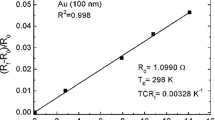Abstract
The excess conductivity due to the thermodynamic fluctuations in aluminum films is experimentally investigated. The excess conductivity is described by the sum of the Aslamazov-Larkin and the Maki-Thompson terms. An empirical formula is found on the relation between the pair-breaking parameter δ(0) in the absence of the magnetic field and the normal-state film resistanceR sqN as δ(0)=6×10−4 R sqN . This formula might be explained in terms of the localized moments and the proximity effect in films. The result of the magnetic field dependence of the pair-breaking parameter revealed that δ(0) cannot be described by an effective magnetic field. The temperature dependence of the excess conductivity at higher temperatures systematically deviates from the theoretical values due to the breakdown of the mean-field theory.
Similar content being viewed by others
References
R. E. Glover,Phys. Letters 25A, 542 (1967); D. C. Naugle and R. E. Glover,Phys. Letters 28A, 110 (1968).
R. D. Parks,The Twelfth International Conference on Low Temperature Physics, Kyoto, 1970, to be published.
P. C. Hohenberg,The Twelfth International Conference on Low Temperature Physics, Kyoto, 1970, to be published.
L. G. Aslamazov and A. I. Larkin,Fiz. Tverd. Tela 10, 1104 (1968) [English transl.,Soviet Phys.—Solid State 10, 875 (1968)];Phys. Letters 26A, 238 (1968).
M. Strongin, O. F. Kammerer, J. Crow, R. S. Thompson, and H. L. Fine,Phys. Rev. Letters 20, 922 (1968).
R. O. Smith, B. Serin, and E. Abrahams,Phys. Letters 28A, 224 (1968).
L. R. Testardi, W. A. Reed, P. C. Hohenberg, W. H. Haemmerle, and G. F. Brennert,Phys. Rev. 181, 800 (1969).
W. E. Masker and R. D. Parks,Phys. Rev. B1, 2164 (1970).
A. K. Bhatnagar, P. Kahn, and T. J. Zammit,Solid State Commun. 8, 79 (1970).
J. E. Crow, R. S. Thompson, M. A. Klenin, and A. K. Bhatnagar,Phys. Rev. Letters 24, 371 (1970).
K. Kajimura and N. Mikoshiba,Phys. Letters 32A, 216 (1970).
K. Kajimura and N. Mikoshiba,Solid State Commun. 8, 1617 (1970).
B. Serin, R. O. Smith, and T. Mizusaki,International Conference on the Science of Superconductivity, Stanford, 1969, to be published.
K. Maki,Progr. Theoret. Phys. (Kyoto)40, 193 (1968).
R. S. Thompson,Phys. Rev. B1, 327 (1970).
E. Abrahams and J. W. F. Woo,Phys. Letters 27A, 117 (1968).
A. Schmid,Z. Physik 215, 210 (1968).
H. Schmidt,Z. Physik 216, 336 (1968).
A. Schmid,Phys. Kondensierten Materie 5, 302 (1966).
E. Abrahams and T. Tsuneto,Phys. Rev. 152, 416 (1966).
L. P. Gor'kov and G. M. Eliashberg,Zh. Eksperim. i Teor. Fiz. 54, 612 (1968) [English transl.,Soviet Phys.—JETP 27, 328 (1968)].
H. L. Caswell,J. Appl. Phys. 32, 105 (1961).
J. P. Hurault,Phys. Rev. 179, 494 (1969).
A. Schmid,Phys. Rev. 180, 527 (1969).
T. Tsuzuki,Progr. Theoret. Phys. (Kyoto)43, 286 (1970).
K. Kajimura, N. Mikoshiba, and K. Yamaji,Phys. Rev., to be published.
E. Abrahams, R. E. Prange, and M. J. Stephen,International Conference on the Science of Superconductivity, Stanford, 1969, to be published. The procedure to determineR N by using the Abrahamset al. formula was first developed by Mizusakiet al. See T. Mizusaki, Ph.D. thesis, Rutgers University (1971) (unpublished) and see also Ref. 13.
F. E. Harper and M. Tinkham,Phys. Rev. 172, 441 (1968).
L. P. Gor'kov,Zh Eksperim. i Teor. Fiz. 37, 1407 (1959) [English transl.,Soviet Phys.—JETP 10, 998 (1960)]; D. Saint-James, G. Sarma, and E. J. Thomas,Type II Superconductivity (Pergamon Press, Oxford, 1969), p. 151.
S. Caplan and G. Chanin,Phys. Rev. 138, A 1428 (1965).
W. E. Masker, S. Marčelja, and R. D. Parks,Phys. Rev. 188, 745 (1969).
K. Maki,Superconductivity, R. D. Parks, ed. (Marcel Dekker, New York, 1969), p. 1035.
M. Strongin, R. S. Thompson, O. F. Kammer, and J. E. Crow,Phys. Rev. B1, 1078 (1970).
O. Kubaschewski and B. E. Hopkins,Oxidation of Metals and Alloys (Butterworths, London, 1967).
Handbook of Chemistry and Physics, C. D. Hodgman, ed. (The Chemical Rubber Publishing Co., Ohio, 1962), p. 2731.
H. Launius and H. Alloul,Solid State Commun. 7, 525 (1969).
D. G. Naugle and R. E. Glover,Phys. Letters 28A, 611 (1969).
L. N. Cooper,Phys. Rev. Letters 6, 689 (1961); W. Silvert and L. N. Cooper,Phys. Rev. 141, 336 (1966).
P. G. de Gennes,Superconductivity of Metals and Alloys (W. A. Benjamin, New York, 1966), pp. 227–232.
W. L. McMillan,Phys. Rev. 167, 331 (1968).
J. W. Garland, K. H. Bennemann, and F. M. Mueller,Phys. Rev. Letters 21, 1315 (1968).
J. Appel,Phys. Rev. Letters 21, 1164 (1968).
Author information
Authors and Affiliations
Rights and permissions
About this article
Cite this article
Kajimura, K., Mikoshiba, N. Fluctuations in the resistive transition in aluminum films. J Low Temp Phys 4, 331–348 (1971). https://doi.org/10.1007/BF00629719
Received:
Issue Date:
DOI: https://doi.org/10.1007/BF00629719




